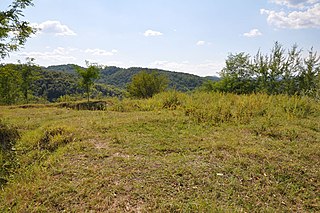Related Research Articles

Sarmizegetusa Regia was the capital and the most important military, religious and political centre of the Dacians before the wars with the Roman Empire. Built on top of a 1200 m high mountain, the fortress, consisting of six citadels, was the core of a strategic and defensive system in the Orăștie Mountains.

Kogaionon is a mammal genus from the Upper Cretaceous of Romania. It lived in Transylvania the same time as some of the last non-avian dinosaurs and was a member of the extinct order of Multituberculata. It was named after Kogaionon, the holy mountain of the ancient Dacians. It lies within the suborder Cimolodonta and the family Kogaionidae. The genus Kogaionon was named by Rădulescu R. and Samson P. in 1996.

The Thracian language is an extinct and poorly attested language, spoken in ancient times in Southeast Europe by the Thracians. The linguistic affinities of the Thracian language are poorly understood, but it is generally agreed that it was an Indo-European language with satem features.

Argedava was an important Dacian town mentioned in the Decree of Dionysopolis (48 BC), and potentially located at Popești, a district in the town of Mihăilești, Giurgiu County, Muntenia, Romania.

Argidava was a Dacian fortress town close to the Danube, inhabited and governed by the Albocense. Located in today's Vărădia, Caraș-Severin County, Romania.

Aedava was a Dacian settlement located south of the Danube in Moesia. In his De Aedificiis, the 6th century AD historian Procopius placed Aedava on the Danubian road between Augustae and Variana. He also mentioned that Emperor Justinian restored the damaged portion of the town defenses.

Cumidava was originally a Dacian settlement, and later a Roman military camp on the site of the modern city of Râșnov in Romania.
Bregedava was a Dacian town.

Buridava (Burridava) was a Dacian town situated in Dacia, later Dacia Apulensis, now Romania, on the banks of the river Aluta, now Olt.
Buteridava was a Dacian town.
Danedevae was a Dacian town.
Dausdava was a Dacian town in Moesia between the Danube and the Balkan Mountains, in the region between Nicopolis and Abritus.
Itadava was a Dacian town, in the territory of the fortress with unknown name near Burgaraca.
Marcodava was a Dacian town, north-west of Apulon.
Murideva was a Dacian town in Scythia Minor, not far from Zaldapa.
Perburidava was a Dacian town.
Recidava was a Dacian town.
Scaidava was a Dacian town between Iatrus and Trimammium (Ablanovo) near the village of Batin, Bulgaria.
Keiladeva was a Dacian town mentioned in toponomastic inscriptions.
References
- Dicţionar de istorie veche a României ("Dictionary of ancient Romanian history") (1976) Editura Ştiinţifică şi Enciclopedică, pp. 363
- Olteanu, Sorin. Καγα: an important Dacian word in Tomitian inscriptions.